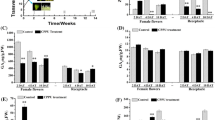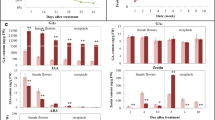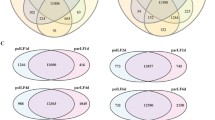Abstract
San Pedro-type fig (Ficus carica L.) produces two crops a year, parthenocarpic breba and non-parthenocarpic main crop. The mechanism underlying the two crops’ differential parthenocarpy is largely unknown. For the first time, transcriptomic analysis of young breba and main crop at four stages of developmental phase I was performed by RNA sequencing, including two pre-anthesis young fruit stages and flowers at anthesis and post-anthesis stages. KEGG enrichment analysis demonstrated that plant hormone signal transduction, zeatin biosynthesis, and diterpenoid biosynthesis pathways are differentially expressed in all main crop vs. breba groups. Further comparison demonstrated significant downregulation of IAA-amino acid hydrolase and GA20ox and upregulation of GA2ox, NCED and ACS in plant hormone synthesis and catabolism pathways in the main crop samples compared to breba, while upregulation of multiple AUX/IAA, DELLA, PP2C, and EFR transcripts characterized the main crop plant hormone signaling pathway. Plant hormone assay revealed significantly lower IAA content in very young main crop fruit and this difference was maintained until the post-anthesis flower stage, when gibberellin was also lower in main crop flowers, whereas zeatin and ABA were higher than in breba. Our results suggest that divergence of the parthenocarpic fates of breba and main crop of San Pedro-type fig occur at very early stages of syconia development where auxin may play a major role, in the absence of pollination. Main crop abscission at the end of phase I was modulated by differentially expressed phytohormone metabolism and signaling pathways.








Similar content being viewed by others
References
Alabadí D, Aguero MS, Pérez-Amador MA, Carbonell J (1996) Arginase, arginine decarboxylase, ornithine decarboxylase, and polyamines in tomato ovaries (changes in unpollinated ovaries and parthenocarpic fruits induced by auxin or gibberellin). Plant Physiol 112:1237–1244
Arias M, Carbonell J, Agustí M (2005) Endogenous free polyamines and their role in fruit set of low and high parthenocarpic ability citrus cultivars. J Plant Physiol 162:845–853
Beck N, Lord, E (1988) Breeding system in Ficus carica, the common fig. II. Pollination events. Am J Bot:1913-1922
Conesa A, Gotz S, Garcia-Gomez JM, Terol J, Talon M, Robles M (2005) Blast2GO: a universal tool for annotation, visualization and analysis in functional genomics research. Bioinformatics 21:3674–3676
Crane J, Campbell R (1958) Breaking rest and inducing parthenocarpy in the Calimyrna fig with gibberellin. In: Proc. 15th Intern. Hort. Congress, Nice, France
Crane JC, Van Overbeek J (1965) Kinin-induced parthenocarpy in the fig, Ficus carica L. Science 147:1468–1469
De Jong M, Mariani C, Vriezen WH (2009) The role of auxin and gibberellin in tomato fruit set. J Exp Bot:erp094
Ding J, Chen B, Xia X, Mao W, Shi K, Zhou Y, Yu J (2013) Cytokinin-induced parthenocarpic fruit development in tomato is partly dependent on enhanced gibberellin and auxin biosynthesis. Plos One:8. doi:10.1371/journal.pone.0070080
Du L, Bao C, Hu T, Zhu Q, Hu H, He Q, Mao W (2016) SmARF8, a transcription factor involved in parthenocarpy in eggplant. Mol Gen Genomics 291(1):93–105
Flaishman MA, Rodov V, Stover E (2008) The fig: botany, horticulture, and breeding. In Horticultural reviews, Volume 34. In: Janick J (ed) . John Wiley & Sons, Inc, Hoboken. doi:10.1002/9780470380147.ch2
Freiman ZE, Rosianskey Y, Dasmohapatra R, Kamara I, Flaishman MA (2015) The ambiguous ripening nature of the fig (Ficus carica L.) fruit: a gene-expression study of potential ripening regulators and ethylene-related genes. J Exp Bot:erv140
Fu FQ, Mao WH, Shi K, Zhou YH, Asami T, Yu JQ (2008) A role of brassinosteroids in early fruit development in cucumber. J Exp Bot 9(9):2299–2308
García-Hurtado N, Carrera E, Ruiz-Rivero O, López-GresaMP HP, Gong F, García-Martínez JL (2012) The characterization of transgenic tomato overexpressing gibberellin 20-oxidase reveals induction of parthenocarpic fruit growth, higher yield, and alteration of the gibberellin biosynthetic pathway. J Exp Bot 63(16):5803–5813
George WL, Scott JW, Splittstoesser WE (1984) Parthenocarpy in tomato. Hortic Rev 6:65–84
Goetz M, Hooper LC, Johnson SD, Rodrigues JCM, Vivian-Smith A, Koltunow AM (2007) Expression of aberrant forms of auxin response factor8 stimulates parthenocarpy in Arabidopsis and tomato. Plant Physiol 145:351–366
Gorguet B et al (2008) Mapping and characterization of novel parthenocarpy QTLs in tomato. Theor Appl Genet 116:755–767
Gorguet B, Van Heusden A, Lindhout P (2005) Parthenocarpic fruit development in tomato. Plant Biol 7:131–139
Grabherr MG et al (2011) Full-length transcriptome assembly from RNA-Seq data without a reference genome. Nat Biotechnol 29:644–U130. doi:10.1038/nbt.1883
Gustafson FG (1942) Parthenocarpy: natural and artificial. Bot Rev 8:599–654
Ingrosso I, Bonsegna S, De Domenico S, Laddomada B, Blando F, Santino A, Giovinazzo G (2011) Over-expression of a grape stilbene synthase gene in tomato induces parthenocarpy and causes abnormal pollen development. Plant Physiol Biochem 49:1092–1099
Iseli C, Jongeneel CV, Bucher P (1999) ESTScan: a program for detecting, evaluating, and reconstructing potential coding regions in EST sequences. Proc Int Conf Intell Syst Mol Biol:138–148
Kjellberg F, Gouyon P-H, Ibrahim M, Raymond M, Valdeyron G (1987) The stability of the symbiosis between dioecious figs and their pollinators: a study of Ficus carica L. and Blastophaga psenes L. Evolution: 693–704
Kuang JF, Wu JY, Zhong HY, Li CQ, Chen JY, Lu WJ, Li JG (2012) Carbohydrate stress affecting fruitlet abscission and expression of genes related to auxin signal transduction pathway in litchi. Int J Mol Sci 13:16084–16103
Li J et al (2014) Transcriptome comparison of global distinctive features between pollination and parthenocarpic fruit set reveals transcriptional Phytohormone cross-talk in cucumber (Cucumis sativus L.) Plant Cell Physiol 55:1325–1342. doi:10.1093/pcp/pcu051
Li R, Yu C, Li Y, Lam T-W, Yiu S-M, Kristiansen K, Wang J (2009) SOAP2: an improved ultrafast tool for short read alignment. Bioinformatics 25:1966–1967
Lian HL, Yu X, Lane D, Sun WN, Tang ZC, Su WA (2006) Upland rice and lowland rice exhibited different PIP expression under water deficit and ABA treatment. Cell Res 16:651–660
Livak KJ, Schmittgen TD (2001) Analysis of relative gene expression data using real-time quantitative PCR and the 2−ΔΔCT method. Methods 25:402–408
Lodhi F, Bradley MV, Crane JC (1969) Auxins and gibberellin-like substances in parthenocarpic and non-parthenocarpic syconia of Ficus carica L., cv. King. Plant Physiol 44:555–561
Marei N, Crane JC (1971) Growth and respiratory response of fig (Ficus carica L. cv. Mission) fruits to ethylene. Plant Physiol 48(3):249–254
Mariotti L, Picciarelli P, Lombardi L, Ceccarelli N (2011) Fruit-set and early fruit growth in tomato are associated with increases in indoleacetic acid, cytokinin, and bioactive gibberellin contents. J Plant Growth Regul 30:405–415. doi:10.1007/s00344-011-9204-1
Martí C, Orzáez D, Ellul P, Moreno V, Carbonell J, Granell A (2007) Silencing of DELLA induces facultative parthenocarpy in tomato fruits. Plant J 52:865–876
Mesejo C et al (2016) Gibberellin reactivates and maintains ovary-wall cell division causing fruit set in parthenocarpic citrus species. Plant Sci 247:13–24. doi:10.1016/j.plantsci.2016.02.018
Mignolli F, Laura Vidoz M, Mariotti L, Lombardi L, Picciarelli P (2015) Induction of gibberellin 20-oxidases and repression of gibberellin 2 beta-oxidases in unfertilized ovaries of entire tomato mutant, leads to accumulation of active gibberellins and parthenocarpic fruit formation. Plant Growth Regul 75:415–425. doi:10.1007/s10725-014-0002-1
Mortazavi A, Williams BA, McCue K, Schaeffer L, Wold B (2008) Mapping and quantifying mammalian transcriptomes by RNA-Seq. Nat Methods 5:621–628
Nitsch LMC et al (2009) Abscisic acid levels in tomato ovaries are regulated by LeNCED1 and SlCYP707A1. Planta 229:1335–1346
Pandolfini T, Rotino GL, Camerini S, Defez R, Spena A (2002) Optimisation of transgene action at the post-transcriptional level: high quality parthenocarpic fruits in industrial tomatoes. BMC Biotechnol 2:1
Rampey RA, LeClere S, Kowalczyk M, Ljung K, Sandberg G, Bartel B (2004) A family of auxin-conjugate hydrolases that contributes to free indole-3-acetic acid levels during Arabidopsis germination. Plant Physiol 135:978–988. doi:10.1104/pp.104.039677
Reid KE, Olsson N, Schlosser J, Peng F, Lund ST (2006) An optimized grapevine RNA isolation procedure and statistical determination of reference genes for real-time RT-PCR during berry development. BMC Plant Biol 6:1
Rosianski Y, Doron-Faigenboim A, Freiman Z, Lama K, Milo-Cochavi S, Dahan Y, Kerem Z, Flaishman MA (2016a) Tissue-specific transcriptome and hormonal regulation of pollinated and parthenocarpic fig (Ficus carica L.) fruit suggest that fruit ripening is coordinated by the reproductive part of the syconium. Front Plant Sci 7:1696. doi:10.3389/fpls.2016.01696
Rosianski Y, Freiman ZE, Cochavi SM, Yablovitz Z, Kerem Z, Flaishman MA (2016b) Advanced analysis of developmental and ripening characteristics of pollinated common-type fig (Ficus carica L.) Sci Hortic 198:98–106
Sardos J, Rouard M, Hueber Y, Cenci A, Hyma KE, Van Den Houwe I, Roux N (2016) A genome-wide association study on the seedless phenotype in banana (Musa spp.) reveals the potential of a selected panel to detect candidate genes in a vegetatively propagated crop. Plos One 11(5):e0154448
Schijlen EG et al (2007) RNA interference silencing of chalcone synthase, the first step in the flavonoid biosynthesis pathway, leads to parthenocarpic tomato fruits. Plant Physiol 144:1520–1530
Serrani JC, Carrera E, Ruiz-Rivero O, Gallego-Giraldo L, Peres LE, Garcia-Martinez JL (2010) Inhibition of auxin transport from the ovary or from the apical shoot induces parthenocarpic fruit-set in tomato mediated by gibberellins. Plant Physiol: pp. 110.155424
Serrani JC, Fos M, Atares A, Garcia-Martinez JL (2007) Effect of gibberellin and auxin on parthenocarpic fruit growth induction in the cv micro-tom of tomato. J Plant Growth Regul 26:211–221. doi:10.1007/s00344-007-9014-7
Serrani JC, Ruiz-Rivero O, Fos M, Garcia-Martinez JL (2008) Auxin-induced fruit-set in tomato is mediated in part by gibberellins. Plant J 56:922–934. doi:10.1111/j.1365-313X.2008.03654.x
Shinozaki Y, Hao S, Kojima M, Sakakibara H, Ozeki-Iida Y, Zheng Y, Okabe Y (2015) Ethylene suppresses tomato (Solanum lycopersicum) fruit set through modification of gibberellin metabolism. Plant J 83(2):237–251
Shiozaki S, Ogata T, Horiuchi S, Zhuo X (1998) Involvement of polyamines in gibberellin-induced development of seedless grape berries. Plant Growth Regul 25(3):187–193
Sun Z, Staub J, Chung S, Lower R (2006) Identification and comparative analysis of quantitative trait loci associated with parthenocarpy in processing cucumber. Plant Breed 125:281–287
Tang N, Deng W, Hu G, Hu N, Li Z (2015) Transcriptome profiling reveals the regulatory mechanism underlying pollination dependent and parthenocarpic fruit set mainly mediated by auxin and gibberellin. PLoS One 10(4):e0125355
Varga A, Bruinsma J (1986) Tomato. In: Monselise SP (ed) CRC handbook of fruitset and development. CRCPress, Boca Raton, FL, pp 461–480
Vivian-Smith A, Koltunow AM (1999) Genetic analysis of growth-regulator-induced parthenocarpy in Arabidopsis. Plant Physiol 121:437–451. doi:10.1104/pp.121.2.437
Wu Z, Zhang T, Li L, Xu J, Qin X, Zhang T, Chen J (2016) Identification of a stable major-effect QTL (Parth 2.1) controlling parthenocarpy in cucumber and associated candidate gene analysis via whole genome re-sequencing. BMC Plant Biol 16(1):182
Ye J et al (2006) WEGO: a web tool for plotting GO annotations. Nucleic Acids Res 34:W293–W297. doi:10.1093/nar/gkl1031
Zhang M, Yuan B, Leng P (2009) The role of ABA in triggering ethylene biosynthesis and ripening of tomato fruit. J Exp Bot 60:1579–1588. doi:10.1093/jxb/erp026
Zhao J et al. (2015) Moderately enhancing cytokinin level by down-regulation of GhCKX expression in cotton concurrently increases fiber and seed yield. Mol Breeding 35 doi:10.1007/s11032-015-0232-6
Ziliotto F, Begheldo M, Rasori A, Bonghi C, Tonutti P (2008) Transcriptome profiling of ripening nectarine (Prunus persica L. Batsch) fruit treated with 1-MCP. J Exp Bot 59(10):2781–2791
Acknowledgements
This work was supported by the National Natural Science Foundation of China project NSFC [31372007].
Data archiving statement
The transcriptome assembly project has been deposited at DDBJ/EMBL/GenBank under the accession number GDKC00000000. The version described in this paper is the first version, GDKC01000000. Raw sequencing data of all breba and main crop samples have been submitted to the NCBI Sequence Read Archive (SRA, http://www.ncbi.nlm.nih.gov/Traces/sra) with accession number SRP060409.
Author information
Authors and Affiliations
Corresponding author
Additional information
Communicated by A. M. Dandekar
Electronic supplementary material
ESM 1
(PDF 1121 kb).
Rights and permissions
About this article
Cite this article
Chai, L., Wang, Z., Chai, P. et al. Transcriptome analysis of San Pedro-type fig (Ficus carica L.) parthenocarpic breba and non-parthenocarpic main crop reveals divergent phytohormone-related gene expression. Tree Genetics & Genomes 13, 83 (2017). https://doi.org/10.1007/s11295-017-1166-4
Received:
Revised:
Accepted:
Published:
DOI: https://doi.org/10.1007/s11295-017-1166-4




